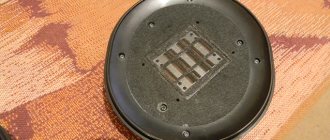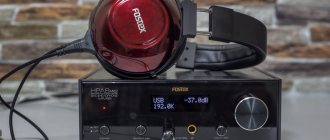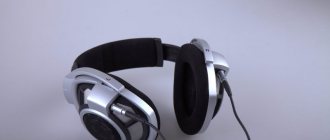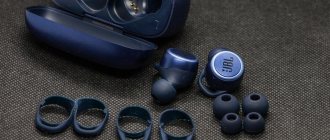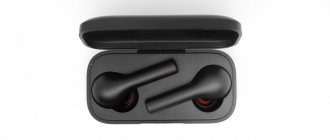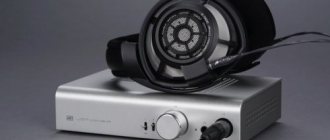Fostex T50RP are widely known for two reasons - the use of a rare isodynamic driver and a low price not found in competitors. Isodynamics falls between conventional dynamic drivers (compatible with standard amplifiers) and electrostats with a completely flat driver.
The T50 RP are professional headphones with a neutral sound that many find bland. Low price is one of the main factors for various types of modding and below will be one of them. Hi-FiMan and Abyss appeared later and in a more expensive segment, losing to the T50 RP in terms of ergonomics and heavy weight.
Prerequisites for modding Fostex T50RP
Here's what SGS writes on its blog: “... in my opinion, their driver design is flawed, despite the fact that the membrane is of very high quality, albeit small. Here they mentioned the influence of the mesh on the sound, but what do we have with this driver? Fostex saved on magnets, instead of five he put 3, and the role of the rest is played by a metal plate between them in which 42 holes of 2 mm in diameter were made for the passage of sound with a total equivalent area of 132 mm2. This corresponds to a hole with a diameter of about 13mm or approximately 15% of the membrane area. In addition, the holes are so small that they are equal to or less than the wavelength of the emitted sound. From the school physics course I vaguely remember that in this case the wave is emitted as if from a point with a circular front. I think this is called diffraction. Then the waves add up again with different phases at different points in space and this phenomenon is called interference. I'm not even saying that the sound is locked between two bare metals. plates and is reflected from them many times before breaking out. Why then be surprised at the cottony, muddy sound of the Fostexes and that their sound is so different from other isodynamics.”
Comments from the author of the mod in question:
So, I completely removed all the partitions between the magnets on the outer half of the driver, freeing up space for sound as much as possible. Firm, controlled damping was applied to the inner half of the driver by sealing the “extra” holes with natural suede.
There is additional felt damping on the outside of the driver with an adjustable hole to tailor the tonal balance to the specific path and listener preference. In addition, the thickness of the additional gasket between the phone body and the ear pads was selected.
Among other things, the cable was also replaced with a CANARE L-2T2S (with the “correct” wiring directly to the drivers). Now the eternal bug with channel imbalance from an oxidized connector on the earcup is a thing of the past.
Reworking the magnetic system must first of all affect the sensitivity of the headphones due to a decrease in the magnetic flux, and objective measurements clearly confirm this.
The main change in the frequency response is expressed in a decrease in output in the mid-frequency region to 12 dB.
The overall sound of the headphones is radically different from the stock ones - a completely different frequency balance. If the stock ones stand out in the middle and moderate lows and highs, then the modified ones have deep bass and brighter highs. From the standpoint of professional use, modified headphones color the sound too much, but from the standpoint of an audiophile who needs a pleasant and interesting sound, this is what they need. Together with the new tonal balance, the cohesion and naturalness of the scene, characteristic of headphones with a flat driver, is completely preserved, when the scene is perceived naturally and naturally.
Modified headphones are more demanding of amplification and require a more powerful amplifier due to reduced sensitivity.
After getting acquainted with the mod, it’s a pity that instead of releasing a similar version by Fostex themselves, they instead released modifications of the famous headphones from Denon in the form of TH 600 and TH 900 without the use of isodynamic drivers.
Characteristics of Fostex TR-70, TR-80 and TR-90
| Fostex TR-70 | Fostex TR-80 | Fostex TR-90 | |
| Headphone type | Dynamic | Dynamic | Dynamic |
| Acoustic design | Open | Closed | Half open |
| Membrane diameter | 40 mm | 40 mm | 40 mm |
| Resistance | 80 Ohm / 250 Ohm | 80 Ohm / 250 Ohm | 80 Ohm / 250 Ohm |
| Sensitivity | 93 dB/mW | 90-96 dB/mW | 90-92 dB/mW |
| Frequency range | 5 - 35.000 Hz | 5 - 35.000 Hz | 5 - 35.000 Hz |
| Maximum input power | 100 mW | 100 mW | 100 mW |
| Weight | 298 g / 304 g | 292 g / 298 g | 302 g / 308 g |
| Length of cable | Straight and twisted, 3 m | Straight and twisted, 3 m | Straight and twisted, 3 m |
| Plug | 3.5 mm + 6.3 mm adapter | 3.5 mm + 6.3 mm adapter | 3.5 mm + 6.3 mm adapter |
The manufacturer positions Fostex TR-90 as the senior model in the line. The semi-open acoustic design provides a high level of sound saturation, as well as excellent detail. Fostex TR-80, on the contrary, are dynamic closed-type headphones, characterized by well-balanced frequencies and excellent sound. The youngest, but not least, is the TR-70 - open acoustic design and natural sound.
Technical measurements of Fostex T50 RP
Original Fostex T50 RP
The sensitivity of the original Fostex T50 RP is initially low, about 105 dB/V, and with a low resistance of 50 Ohms, it places increased demands on the amplifier, which must have a high output voltage and operate without distortion with a low-impedance load. RAA Report:
Fostex T50RP Detailed Report
Modified Fostex T50 RP
The modified headphones have sensitivity at a comparable level to high-impedance headphones at 98 dB/V. Although it must be admitted that the value is not as low as, for example, the Hi-FiMan, where the sensitivity of the models is lower by another 8-10 dB (HE-6 and HE-4) with even lower resistance. RAA Report:
Detailed report of modified Fostex T50RP
The modification can be considered successful if we are talking about a fundamental difference in sound and intended use, but it is worth remembering that the requirements for the amplifier have increased due to decreased sensitivity. Among isodynamic models with a “smooth” sound, this mod is a kind of “Hi-Fi” with an emphasis on low and very high frequencies, a kind of “audiophile” version.
Author:
08.09.2013
Found a typo in the text?
Select and press
Ctrl+Enter
. This does not require registration. Thank you.
Equipment
The cardboard box, which looks inconspicuous at first glance, hides a good set of accessories. In addition to the headphones themselves, there are two types of cables (twisted and straight) 3 m long. A necessary thing for professionals is an adapter from 3.5 mm to 6.3 mm (in case you lost everything), plus various documentation and a small eco-friendly bag. skin - a trifle, but nice.
However, additional cushions for ear pads of increased thickness deserve special attention. Will there be that much of a difference when listening? We'll find out soon.
Sound
At first they wanted to compare the headphones with the Fostex T-7, but then they came to the conclusion that an analogy with the same T40RP MK3 would be more suitable. In comparison, the entire TR line plays brightly and engagingly, even the TR-70, despite the open acoustic design. With your permission, we won’t talk about the imaginary stage, the volume of instruments and deep bass; it’s better to pay attention to whether the resistance and changing the ear pads affects the sound quality (by the way, replacing standard ones with thicker ones requires some skill).
According to subjective feelings, with thick ear pads the sound is more interesting and bassier, regardless of where the headphones are connected to. Maybe it’s because the thicker ones are softer and more comfortable, and the ears feel more spacious in them. Someone says that you should listen to vocals only on standard ones - they say, the voice becomes “dull”. Did not notice. It’s better to listen on your own, preferably immediately comparing it with other models.
Of course, there is no point in connecting headphones with an impedance of 250 Ohms to a regular smartphone (we have already said why). Therefore, we immediately put our iPhones aside and pick up the player, the same OPPO HA-2. The headphones immediately play in a new way, and it’s noticeable. However, the most impressive effect can be achieved when connecting headphones to a stationary system. It’s not for nothing that the entire TR line is positioned more as a studio product.
What to choose?
We seem to have sorted out the resistance, but what about the acoustic design? Here, everyone again selects headphones to suit their needs. Yes, the closed design of the device is more practical and easy to use, while open headphones produce a more natural sound. So it all depends more on where you will use the TR-70, TR-80 or TR-90.
I can’t help but be glad that Fostex was able to find the optimal balance between the sound of the headphones, their appearance and price - now the word “studio” does not confuse many. In fact, as we said at the beginning, all three representatives of the line are suitable for both professional and personal use. The main thing is to choose the right acoustic design and resistance.
Appearance
Since the headphones are more affordable than the same TH-610 or TH-900, the materials in the TR line are also simpler: the ear pads and headband are made of artificial leather, the body is plastic, although everything is made of very high quality - take the same stitching on the headband. There is a clear heritage from the Land of the Rising Sun: everything is done with taste.
The design of the TR-70 is very similar to the T40RP MK3, with the exception of different acoustic design. Despite the fact that the diameter of the membrane is 40 mm, Fostex engineers were still able to lower the lower limit of the frequency range to 5 Hz. In the entire TR series, the company uses dynamic drivers of its own design. The cable is removable with a fixation: on the one hand it is convenient, on the other hand it makes it a little difficult to buy a spare wire. But these are perhaps minor things.
On the sides of the headphones there is a mesh, covered and designed in an “aviation” style. Thanks to the mesh, the headphones allow noise to pass in both directions, providing a more natural sound. Yes, they will be problematic in public transport, the metro or on an airplane, but at home, in the office or in the studio they will have no equal. In addition, due to the lower sound pressure characteristic of open headphones, the TR-70 does not put pressure on the ears.
